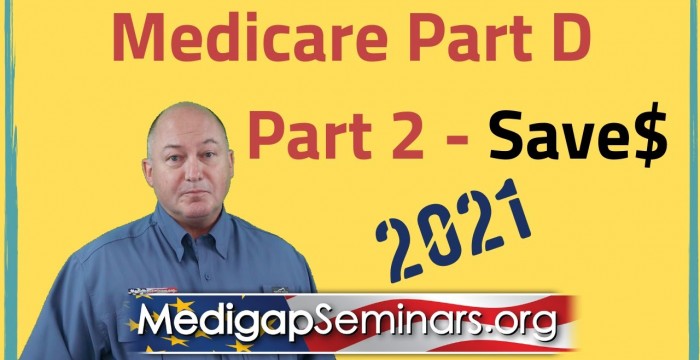Visit for more:
Call Us: 800-847-9680 | Contact Us:
Visit our new with Part D videos & more!
(Available October 15 2020)
Medicare Part D Explained 2021 (Part 2 – donut hole & more)
See Part 1 of Medicare Part D Explained video here:
4 Stages of Part D —
5-Steps to Save on Part D —
Welcome to Part two of Medicare Part D Explained. This is a continuation of the Medicare Part D Explained first video. While the first video included information about Part D for everyone researching their Medicare options, this video includes more advanced concepts that are important to those who are paying hundreds of dollars a month for their prescriptions. I will assume in this video that you have already seen Part 1 of Medicare Part D Explained.
In this video we are going to talk about the four stages of the Medicare Part D prescription drug coverage. This includes the deductible, your initial coverage, the coverage gap (formerly referred to as the donut hole) and catastrophic coverage. We will discuss these stages are impact by your TROOP (True Out-Of-Pocket Expense). Then last, but not least I will touch on Low Income Subsidy options that can be used to help relieve the financial burden of prescription drugs and Part D premiums for those who qualify. If you are having difficulty paying for your prescriptions, this will be very important for you.
If you are spending a lot of money on prescriptions it is important to understand each of these four stages and how the right Part D plan can help you manage your out-of-pocket costs. My objective is to help you understand what you need to know about Medicare Part D plans so that you do not spend more than you have to for your prescriptions.
Four stages…
The first stage is the deductible. A deductible is the amount of money you pay before your insurance will pay any benefit. Each year Medicare sets a maximum deductible that a Medicare Part D plan can charge. They can charge the maximum. They can charge less than the maximum or have no deductible at all. For 2021 the maximum Medicare Part D deductible is $445. I would suspect the amount of the deductible will continue to increase a little each year.
The second stage of your Part D coverage is your Initial Coverage.
After you meet your deductible, for those prescriptions that are not exempt, your Medicare part D Plan will help pay your prescription costs. The Initial Coverage is where you would pay a copay or coinsurance for part of the prescription costs, and the insurance company will pay the rest.
For Stage Three, I need you to understand a new term. You may want to write this down. The term I need you to understand is your True Out-of-Pocket cost, often abbreviated as your TROOP.
TROOP is your total out-of-pocket costs on the prescriptions in your Medicare Part D plan formulary.
Your TROOP includes the money you spend on Part D prescriptions. It also includes money spent on your prescriptions on your behalf. For example, the pharmaceutical manufacturer contribution or discount, or an HSA plan or Medicare Saving Account (MSA) or Flexible Spending Account (FSA). It can also include the Extra Help from a Low-Income Subsidy.
Your TROOP does not include your Part D monthly premium. It does not include drug you pick up over the counter or by using Good Rx.
During Stage Three, or the Coverage Gap, you pay 25% of your dug costs. Your costs go up during this stage. The Part D Plan
You pay 25% of the cost of the prescription. The Pharmaceutical Industry will pay 70% of the prescription and Medicare will pay the remaining 5%.
Catastrophic Coverage is Medicare is simple.
In this stage Medicare will typically pay the greater of 95% of your prescription drug costs or $3.70 for a generic prescription or $9.20 for a brand name prescription.
#MedigapSeminars #MedicarePartD #MedicarePartDExplained #NewToMedicare #Medicare #Medicare2021 #Medicaresupplements #MedicareSupplementPlans #MedigapPlans #MedicareSeminars #MedicareSupplementPlans2021 #donuthole #MedicareExplained






